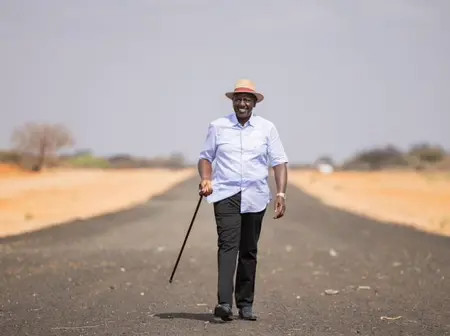When President William Ruto took office in September 2022, he pledged to transform Kenya’s infrastructure as part of his Bottom-Up Economic Transformation Agenda. Three years on, roads remain at the heart of his presidency.
The government says that between 2022 and mid-2025, more than 1,800 kilometres of new tarmac roads have been built and over 1,340 kilometres maintained. Official statistics from the Kenya National Bureau of Statistics show paved roads increased from 22,443 kilometres in 2022 to nearly 24,900 kilometres by June 2024. Yet beneath the figures lies a mixed reality: a blend of completed highways, newly launched projects, revived schemes from previous regimes, and others still stuck in bureaucratic limbo.
New Roads and Launches
In Rift Valley and Western Kenya, President Ruto unveiled a Sh10.7 billion roads programme that included the Silbwet – Merigi – Kaparuso – Tegat – Cheaper – Kimuchul – Matcher road, designed to improve access to Bomet’s agricultural hinterlands. The programme also covered several feeder roads to connect farming communities to markets and social amenities.
In Kajiado County, Ruto launched upgrades for a cluster of urban and peri-urban roads to ease traffic pressure around Ongata Rongai and Karen. These include the Ongata Rongai – Gataka – Embulbul road, the Co-operative College (Karen) – Matasia – Nkoroi road, and the Nazarene University – Rimpa link road, alongside a key junction from C58 to Kahara Market. These roads are expected to relieve congestion on the Magadi and Lang’ata corridors.
Western Kenya also benefited from new contracts, among them the Malava – Kimang’eti – Ikoli road stretching 13 kilometres, meant to boost regional trade and mobility.
Revived and Stalled Projects
Despite the launches, many of Ruto’s road activities have centred on reviving projects that stalled under the previous administration. In Kirinyaga, the Ichamara – Thangathi – Rutune road, a perennial campaign promise, has been re-launched but remains incomplete. Similarly, the Bamba – Ganze – Kilifi road in the Coast region, first unveiled during the Jubilee era, was brought back under Ruto but continues to progress slowly.
Other projects such as the Gatung’ang’a – Chieni – State Lodge road were relaunched despite being only half-finished at the time. Such cases have fuelled criticism that the government has mastered the art of rebranding incomplete projects as new achievements.
Numbers Behind the Politics
Government reports show a downward trend in actual construction compared to promises. In the 2023/24 financial year, road agencies targeted 942 kilometres of new tarmac but achieved just 541 kilometres. The following year, projections stood at 1,026 kilometres, though by April 2025, just over 1,240 kilometres were anticipated if ongoing projects finished on schedule.
Budget Cuts and Policy Shifts
Part of the slowdown is linked to budget rationalisation. In early 2023, the government dropped more than 3,000 kilometres of planned roads from Uhuru’s legacy projects, citing financial constraints and a shift toward completing existing works rather than starting new ones. This policy shift has reduced the number of new contracts but increased emphasis on maintenance and rural access.
Three years into his presidency, William Ruto has overseen visible progress in road building. While thousands of kilometres have been maintained or upgraded, new construction has slowed compared to previous years, with many projects caught in financial or logistical delays.

Leave a Reply